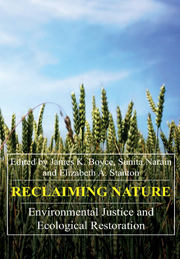Book contents
- Frontmatter
- Contents
- List of Figures and Tables
- Acknowledgements
- Introduction
- Part I ADDING VALUE
- Part II DEMOCRATIZING ACCESS
- Part III CAPTURING BENEFITS
- Part IV DEFENDING THE COMMONS
- 13 International Environmental Justice: Building the Natural Assets of the World's Poor
- 14 Environmental Justice: Reflections from the United States
- 15 Equitable Carbon Revenue Distribution under an International Emissions Trading Regime
- 16 Greenhouse Justice: An Entitlement Framework for Managing the Global Atmospheric Commons
- About the Contributors
- Index
16 - Greenhouse Justice: An Entitlement Framework for Managing the Global Atmospheric Commons
from Part IV - DEFENDING THE COMMONS
Published online by Cambridge University Press: 05 March 2012
- Frontmatter
- Contents
- List of Figures and Tables
- Acknowledgements
- Introduction
- Part I ADDING VALUE
- Part II DEMOCRATIZING ACCESS
- Part III CAPTURING BENEFITS
- Part IV DEFENDING THE COMMONS
- 13 International Environmental Justice: Building the Natural Assets of the World's Poor
- 14 Environmental Justice: Reflections from the United States
- 15 Equitable Carbon Revenue Distribution under an International Emissions Trading Regime
- 16 Greenhouse Justice: An Entitlement Framework for Managing the Global Atmospheric Commons
- About the Contributors
- Index
Summary
Prologue
I first learned about global warming in the late 1980s. My colleague Anil Agarwal and I had spent over two years traversing Indian villages, searching for policies and practices to reforest wasted common lands. We quickly learned to look beyond trees, at ways to deepen democracy so that these commons could be regenerated. In India forests are mostly owned by government agencies, but it is poor communities that actually use them. It quickly became clear that without community participation, afforestation was not possible. This is because our forests are not wilderness areas, but habitats of people and their animals. For people to be involved the rules for engagement had to be respected, and to be respected, the rules had to be fair.
At the time, India had a ‘green’ environment minister. Data released by a prestigious US research institution had convinced her that it was the poor who contributed most substantially to global warming — they did ‘unsustainable’ things like growing rice and keeping farm animals. Anil and I were pulled into the global climate debate when a flummoxed state Chief Minister called us. He had received a government circular that asked him to discourage rural people from keeping animals. ‘How do I do this?’ he asked us. ‘Do the animals of the poor really disrupt the world's climate system?’ We were equally puzzled. It seemed absurd. We had been arguing for quite a while that the poor were victims of environmental degradation.
- Type
- Chapter
- Information
- Reclaiming NatureEnvironmental Justice and Ecological Restoration, pp. 401 - 414Publisher: Anthem PressPrint publication year: 2007
- 2
- Cited by



